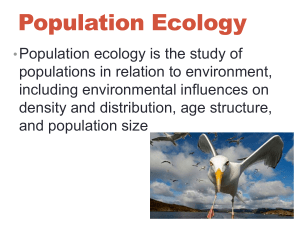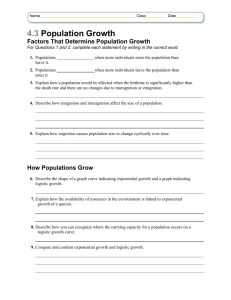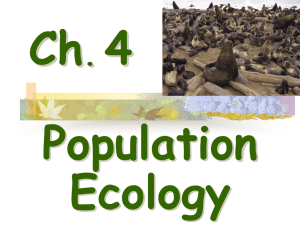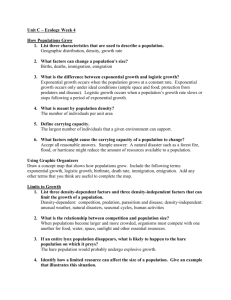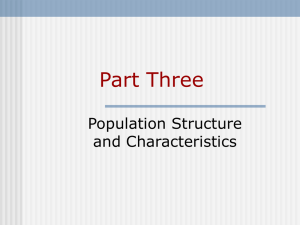years
advertisement
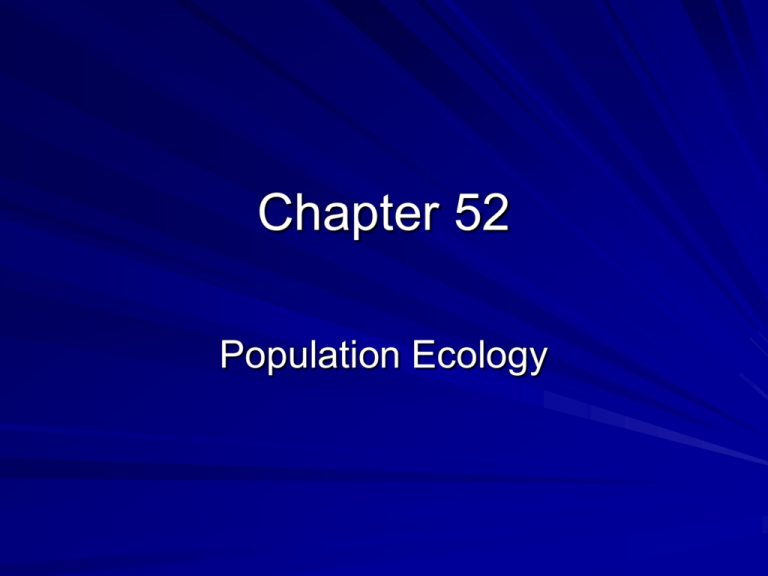
Chapter 52 Population Ecology I. Population Density, Dispersion and Demography Dynamic biological processes – Birth rates/death rates; immigration/emigration – Patterns: Clumped, Uniform, Random Demography – Life tables – Survivorship curves (figures 52.4 and 52.5) – Reproductive rates LE 52-2 Births Immigration Population size Emigration Deaths LE 52-3 Clumped. For many animals, such as these wolves, living in groups increases the effectiveness of hunting, spreads the work of protecting and caring for young, and helps exclude other individuals from their territory. Uniform. Birds nesting on small islands, such as these king penguins on South Georgia Island in the South Atlantic Ocean, often exhibit uniform spacing, maintained by aggressive interactions between neighbors. Random. Dandelions grow from windblown seeds that land at random and later germinate. II. Life History and Natural Selection Life history variables – When reproduction begins, how often, how many Life history diversity – Semelparity (Big bang reproduction) – Iteroparity (Repeated reproduction Trade offs Number of survivors (log scale) LE 52-5 1,000 I 100 II 10 III 1 0 50 Percentage of maximum life span 100 LE 52-8 Most weedy plants, such as this dandelion, grow quickly and produce a large number of seeds, ensuring that at least some will grow into plants and eventually produce seeds themselves. Some plants, such as this coconut palm, produce a moderate number of very large seeds. The large endosperm provides nutrients for the embryo, an adaptation that helps ensure the success of a relatively large fraction of offspring. III. Exponential vs. Logistic Growth Exponential – Unlimited resources Logistic – Carrying capacity LE 52-10 Elephant population 8,000 6,000 4,000 2,000 0 1900 1920 1940 Year 1960 1980 LE 52-12 2,000 Population size (N) dN = 1.0N dt Exponential growth 1,500 K = 1,500 Logistic growth 1,000 dN = 1.0N dt 1,500 – N 1,500 500 0 0 5 10 Number of generations 15 Number of Daphnia/50 mL LE 52-13b 180 150 120 90 60 30 0 0 20 40 60 80 100 120 140 160 Time (days) A Daphnia population in the lab LE 52-13c Number of females 80 60 40 20 0 1975 1980 1985 1990 1995 2000 Time (years) A song sparrow population in its natural habitat IV. Regulation of Populations Density-dependent and densityindependent Dynamics of population growth -> variation Population cycles LE 52-18 Moose population size 2,500 Steady decline probably caused largely by wolf predation 2,000 1,500 1,000 Dramatic collapse caused by severe winter weather and food shortage, leading to starvation of more than 75% of the population 500 0 1960 1970 1980 Year 1990 2000 LE 52-19 Commercial catch (kg) of male crabs (log scale) 730,000 100,000 10,000 1950 1960 1970 Year 1980 1990 Hare population size (thousands) 160 120 Lynx 80 6 40 3 0 0 1850 1875 1900 Year 9 1925 Lynx population size (thousands) LE 52-21 Snowshoe hare V. Human Population Figure 52.23 Regional – Demographic transition – Age structure Global Carrying Capacity 6 5 4 3 2 The Plague 1 8000 B.C. 4000 B.C. 3000 B.C. 2000 B.C. 1000 B.C. 0 1000 A.D. 0 2000 A.D. Human population (billions) LE 52-22 6 5 4 3 2 The Plague 1 8000 B.C. 4000 B.C. 3000 B.C. 2000 B.C. 1000 B.C. 0 1000 A.D. 0 2000 A.D. Human population (billions) LE 52-22 LE 52-25 Rapid growth Afghanistan Male Female Slow growth United States Male Female Age Age 85+ 80–84 75–79 70–74 65–69 60–64 55–59 50–54 45–49 40–44 35–39 30–34 25–29 20–24 15–19 10–14 5–9 0–4 8 6 4 2 0 2 4 6 Percent of population 8 Decrease Italy Male Female 85+ 80–84 75–79 70–74 65–69 60–64 55–59 50–54 45–49 40–44 35–39 30–34 25–29 20–24 15–19 10–14 5–9 0–4 8 6 4 2 0 2 4 6 Percent of population 8 8 6 4 2 0 2 4 6 Percent of population 8 LE 52-26 80 50 Life expectancy (years) Infant mortality (deaths per 1,000 births) 60 40 30 20 60 40 20 10 0 0 Developed countries Developing countries Developed countries Developing countries
